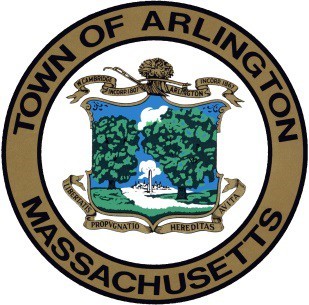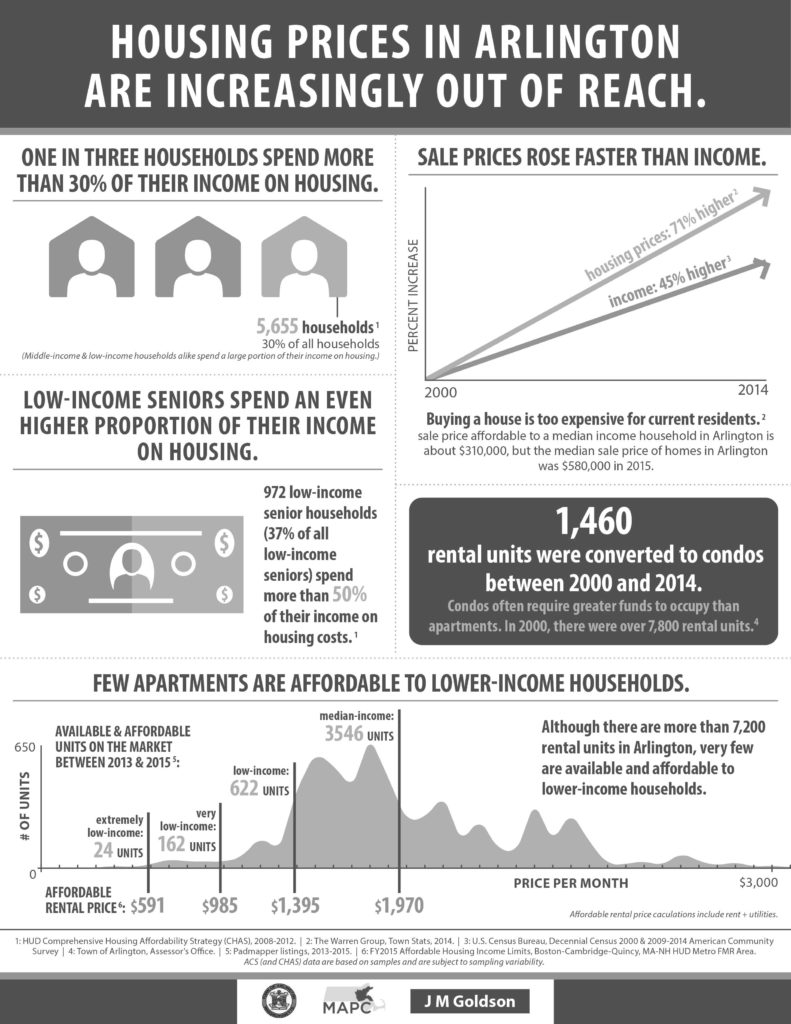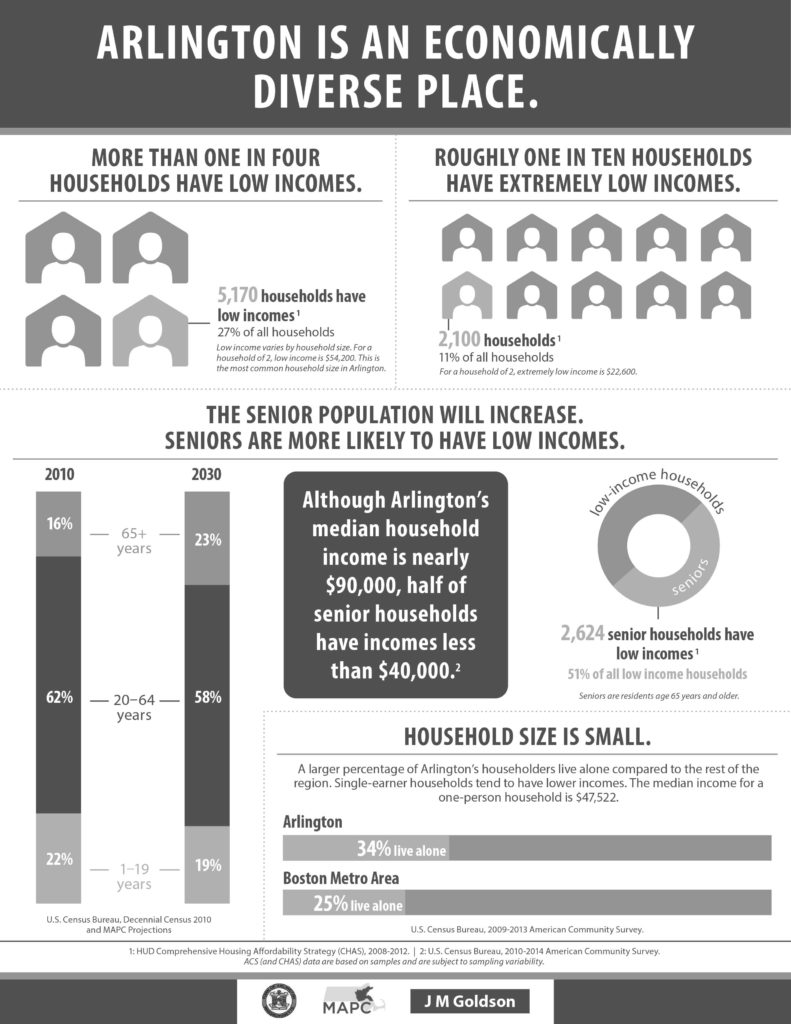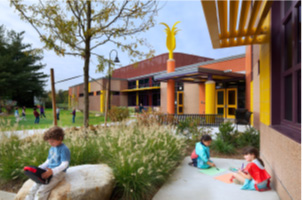Related articles
by Steve Revilak
On Tuesday August 6, 2024, Governor Healey signed the Affordable Homes Act (H.4977) into law. It’s a significant piece of legislation that will take positive strides toward addressing our state’s housing crisis. At 181 pages, the Affordable Homes Act is a lengthy bill, but the things it does generally fall into three categories: funding, changes to state law, and changes to state agencies.
The act authorizes more than five billion dollars to fund the creation, maintenance, and preservation of housing. This includes $425M to housing authorities and local housing initiatives (including $2.5M for the Arlington Housing Authority), $60M to assist homeowners or tenants with a household member with blindness or severe disabilities, $70M for community-based efforts to develop supportive housing for persons with disabilities, and $100M to expand opportunities for first-time homebuyers.
The Affordable Homes Act makes several changes to Massachusetts zoning laws, including the legalization of accessory dwelling units (ADUs) statewide. ADUs, also known as “granny flats” or “in-law apartments,” are a cost-effective way to add new housing, and they’re typically used to provide living quarters for relatives or caretakers, or to generate rental income for homeowners. ADUs are now allowed in all single-family zones in Massachusetts, by right, without the need for a discretionary permit. Arlington has been a leader in this area, having passed an ADU bylaw in 2021, and it’s great to see this option extended throughout the Commonwealth.
Finally, the Affordable Homes Act makes a number of changes to state agencies, especially the Executive Office of Housing and Livable Communities (EOHLC). The Act establishes a new Office of Fair Housing within the EOHLC, to “advance the elimination of housing discrimination.” The Fair Housing office will provide periodic reports on progress towards achieving this goal. EOHLC is also charged with creating and implementing a state-wide housing plan that will consider supply and demand, affordability, challenges unique to different regions of the state, and an analysis of local zoning laws.
While our legislators deserve kudos for putting this package together, they also deserve kudos for what they left out. More than three hundred amendments were filed during House deliberations, and a number of them were intended to weaken the multi-family housing requirements of the MBTA Communities Act. For example, one amendment, simply titled “Technical Correction” would have rewritten the transit community definitions, in order to reduce the housing requirements for Milton. We are heartened that our legislators did not go along with such shenanigans.
The presentation, dated March 11, 2019, includes slides used to present the information necessary to understand the rationale for zoning changes, the location of the zoning areas under consideration and the charts, tables and maps that help describe the situation. The proposed zoning changes, especially articles 6, 7, 8, 11 and 16, only cover changes affecting about 7% of the Town, those parts of the Town that are currently zoned R4-R7 and the B zoning districts.
I’ve had an annual ritual for the past several years: obtain a spreadsheet of property assessments from the Town Assessor, load them in to a database, and run a series of R computations against the data. I started doing this for a number of reasons: to understand what was built where (our zoning laws have changed over time, and there are numerous non-conforming uses), the relationship between land and building values, the capital costs of different types of housing, and how these factors have changed over time.
I’d typically compile these analyses into a fact-book of sorts, and email it around to people that I thought might be interested. This year, I’m going to post the analyses here as a series of articles. This first installment contains basic information about Arlington’s low-density housing: single-, two-, and three-family homes, as well as condominiums. Condominiums are something of an oddball in this category — a condominium can be half of a two-family structure, part of a larger residential building, or somewhere in between. There’s a lot of variety.
Here’s a table showing how the number of units has changed over time, since 2013.
| land use | 2013 | 2014 | 2015 | 2016 | 2017 | 2018 | 2019 | 2020 |
|---|---|---|---|---|---|---|---|---|
| Single Family | 7984 | 7983 | 7991 | 8000 | 7994 | 7994 | 7998 | 7999 |
| Condominium | 3242 | 3304 | 3367 | 3492 | 3552 | 3662 | 3726 | 3827 |
| Two-family | 2352 | 2332 | 2308 | 2282 | 2263 | 2218 | 2183 | 2139 |
| Three-family | 207 | 201 | 196 | 194 | 193 | 190 | 185 | 182 |
Arlington’s predominant form of housing — the single family home — has stayed relatively static; we’ve added 15 over the last seven years. The number of condominiums has increased significantly: +585 over seven years. That, coupled with the reduction of two-family homes (-213) and three-family homes (-25) leads me to believe that a fair number of rental units have been removed from the market.
Next, I’d like to look at how these homes are spread across our various zoning districts. (The “Notes” section at the bottom of the post explains what the zoning district codes mean).
| Zone | Single-Family | Condo | Two-family | Three-family |
|---|---|---|---|---|
| B1 | 8 | 22 | 13 | 11 |
| B2 | 1 | 4 | 1 | |
| B2A | 1 | 18 | ||
| B3 | 59 | 4 | ||
| B4 | 1 | 59 | 5 | 5 |
| B5 | 1 | 1 | ||
| I | 8 | 18 | 7 | 1 |
| R0 | 502 | |||
| R1 | 6798 | 168 | 200 | 7 |
| R2 | 647 | 1816 | 1881 | 124 |
| R3 | 4 | 39 | 11 | 17 |
| R4 | 23 | 79 | 2 | 3 |
| R5 | 3 | 616 | 5 | 4 |
| R6 | 2 | 686 | 8 | 7 |
| R7 | 1 | 243 | 2 | 1 |
A few points to note:
- R0 is our newest district, which was established in 1991. It consists only of conforming single-family homes.
- R1 is Arlington’s original (per 1975 zoning) single-family district. It’s predominantly single-family homes, but there are a fair number of two-family homes, and even a few three-families. The presence of condominiums suggests additional multi-family homes (that consist of two or more condominiums)
- R2 is predominantly two-, and three-family homes. Although three-family homes are no longer allowed in this district, R2 has the largest number of three-families in town.
- Residential uses are no longer allowed in the industrial (I) districts, but the I districts contain 34 homes. These buildings pre-date the current zoning laws (aka “pre-existing non-conforming”). A good portion of the Dudley street industrial district is a residential neighborhood.
I’m pointing out these conformities (and non-conformities) for a reason. The zoning map (and use tables) dictate what is allowed today, along with specifying a vision for the future. Our zoning bylaw happens to contain a strong statement to this effect: “It is the purpose of this Bylaw to discourage the perpetuity of nonconforming uses and structures whenever possible” (section 8.1.1(A)). Despite the strong statement of intent, it can take decades (if not generations) for a built environment to catch up with the bylaw’s prescriptions.
I’ll finish this post with a breakdown of how condominiums are distributed across the various zoning districts:
| Zone | 2013 | 2014 | 2015 | 2016 | 2017 | 2018 | 2019 | 2020 | delta |
|---|---|---|---|---|---|---|---|---|---|
| (N/A) | 14 | 15 | 0 | 0 | 0 | 0 | 0 | 0 | -14 |
| B1 | 16 | 16 | 18 | 18 | 18 | 22 | 22 | 22 | 6 |
| B2 | 2 | 2 | 2 | 2 | 4 | 4 | 4 | 4 | 2 |
| B2A | 19 | 18 | 18 | 18 | 18 | 18 | 18 | 18 | -1 |
| B3 | 55 | 55 | 61 | 59 | 59 | 59 | 59 | 59 | 4 |
| B4 | 47 | 47 | 59 | 59 | 59 | 59 | 59 | 59 | 12 |
| I | 18 | 18 | 18 | 18 | 18 | 18 | 18 | 18 | 0 |
| R1 | 140 | 144 | 146 | 148 | 150 | 154 | 162 | 168 | 28 |
| R2 | 1355 | 1406 | 1456 | 1518 | 1574 | 1670 | 1723 | 1816 | 461 |
| R3 | 22 | 25 | 28 | 31 | 31 | 37 | 37 | 39 | 17 |
| R4 | 65 | 67 | 67 | 79 | 79 | 79 | 79 | 79 | 14 |
| R5 | 616 | 616 | 616 | 616 | 616 | 616 | 616 | 616 | 0 |
| R6 | 630 | 632 | 635 | 683 | 683 | 683 | 686 | 686 | 56 |
| R7 | 243 | 243 | 243 | 243 | 243 | 243 | 243 | 243 | 0 |
The last column (“delta”) shows the difference between 2013 and 2020. The largest increase occurred in the R2 (two-family) district, followed by R6 (medium-density apartments, where most of the increase took place in 2014) and R1 (single-family).
That it will do it for the first installation. In the next post, we’ll look at how the cost (assessed values, actually) of Arlington’s low density housing has changed over the last seven years.
Here is a spreadsheet, containing the various tables shown in this article.
Notes
Arlington’s zoning map divides the town into a set of districts, and each district has regulations about what kinds of buildings and uses are allowed (or not allowed). The districts mentioned in this article are:
- B1 (Neighborhood Office district)
- B2 (Neighborhood Business distrct)
- B2A (Major Business District)
- B3 (Village Business District)
- B4 (Vehicular-Oriented Business District)
- I (Industrial District)
- R0 (Single-Family, large-lot district)
- R1 (Single-Family Distict)
- R2 (Two-Family District)
- R3 (Three-Family District)
- R4 (Townhouse District)
- R5 (Low-Density Apartment District)
- R6 (Medium-Density Apartment District)
- R7 (High-Density Apartment District)
Arlington’s Zoning Bylaw describes each district in detail (see sections 5.4.2, 5.5.2, and 5.6.2)
(DRAFT – 7/11/2019)
Overview

Arlington Planning Department officials report on options for the Town to mitigate the effects of housing demolitions and housing replacements in neighborhoods.
Evidence suggests that lack of appropriate regulatory policies have led to incidences of “mcmansions” and other issues that concern neighborhood residents. This study looks at the data, the policy and regulatory options for Arlington. It also looks at how comparable nearby communities have managed similar circumstances.
This 42 page report covers a great deal of data and analysis of homes by zoning district, gaps in the effectiveness of the current regulatory structure, affects on affordability in Arlington by zoning district, information on housing prices and sales, etc.
“Best practices” include descriptions of demolition delay, expansion of local historic districts, neighborhood conservation districts, design review standards and guidelines and possible revisions to the regulatory framework in Arlington. The report also includes interesting case examples of how comparable communities near Arlington handle these issues.
This report was presented to the Arlington Select Board on July 22.
Read the complete report and see the available data and tables.
(Barbara Thornton, Arlington and Roberta Cameron, Medford)
Our communities need more housing that families and individuals can afford. From 2010 to 2017, Greater Boston communities added 245,000 new jobs but only permitted 71,600 new units of housing. Prices are escalating as homebuyers and renters bid up the prices of the limited supply of housing. As a result, one quarter of all renters in Massachusetts now spend more than 50% of their income on housing. (It should be only about 30% of monthly gross income spent on housing costs.) Municipalities have been over-restricting housing development relative to need. The expensive cost of housing not only affects individual households, but also negatively affects neighborhoods and the region as a whole. Lack of affordability limits income diversity in communities. It makes it harder for businesses to recruit employees.
Over the last two years, researcher Amy Dain, commissioned by the Massachusetts Smart Growth Alliance, has systematically reviewed the bylaws, ordinances, and plans for the 100 cities and towns around Boston to uncover how local zoning affects multifamily housing and why local communities failing to provide enough additional housing to keep the prices from skyrocketing for renters and those who want to purchase homes.
Interested in housing affordability and why the cost of housing is increasing so dramatically to prevent average income residents from affording homes in the 100 municipalities around Boston? Arlington and Medford residents are pleased to welcome author Amy Dain to present her report, THE STATE OF ZONING FOR MULTIFAMILY HOUSING IN GREATER BOSTON (June 2019). Learn more about the so-called “paper wall” restricting production, common trends in local zoning, and best practices to increase production going forward. Learn about efforts in Medford and Arlington to increase housing production and affordable housing and how you can get involved. Thursday, July 25, 2019, 7:00 PM at the Medford Housing Authority, Saltonstall Building, 121 Riverside Avenue, Medford. (Parking is available.)
To access the full report, go to: https://ma-smartgrowth.org/wp-content/uploads/2019/06/03/FINAL_Multi-Family_Housing_Report.pdf
The Massachusetts Smart Growth Alliance, which commissioned the study, provides the following summary of the four principal findings and takeaways:
1) Very little land is zoned for multi-family housing.
For the most part, local zoning keeps new multi-family housing out of existing residential neighborhoods, which cover the majority of the region’s land area.
In addition, cities and towns highly restrict the density of land that is zoned for multi-family use via height limitations, setbacks, and dwelling units per acre. Many of the multi-family zones have already been built out to allowable densities, which mean that although multi-family housing is on the books, it does not exist in practice.
At least a third of the municipalities have virtually no multi-family zoning or plan for growth.
Takeaway: We need to allow concentrated density in multi-family zoning districts that are in sensible locations and allow for incremental growth over a larger area.
2) We are moving to a system of project-by-project decision-making.
Unlike much of the rest of the country, Massachusetts does not require communities to update their zoning on a regular basis and make it consistent with local plans. Although state law ostensibly requires municipalities to update their master plans every ten years, the state does not enforce this provision and most communities lack up-to-date plans.
Instead, the research documents a trend away from predictable zoning districts and toward “floating districts,” project-by-project decision-making, and discretionary permits. Dain found that 57% of multi-family units approved in the region from 2015-2017 were approved by special permit, 22% by 40B (including “friendly” 40B projects), 7% by use variance, and only 14% by “as-of-right” zoning.
There also seems to be a trend toward politicizing development decisions by shifting special permit granting authority to City Council and town meeting. The system emphasizes ad hoc negotiation, which in some cases can achieve a more beneficial project. Yet the overall outcome is a slower, more expensive development process that produces fewer units. Approving projects one by one inhibits the critical infrastructure planning and investments needed to support the growth of an entire district.
Takeaway: We would be better served by a system that retains the benefits of flexibility while offering more speed and predictability.
3) The most widespread trend in zoning for multi-family housing has been to adopt mixed-use zoning.
83 of out of 100 municipalities have adopted some form of mixed-use zoning, most in the last two decades. There is a growing understanding that many people, both old and young, prefer to live in vibrant downtowns, town centers and villages, where they can easily walk to some of the amenities that they want. Malls, plazas and retail areas are increasingly incorporating housing and becoming lifestyle centers.
Yet with few exceptions, the approach to allowing housing in these areas has been cautious and incremental. These projects are only meeting a small portion of the region’s need for housing and often take many years of planning to realize. In addition, the challenges facing the retail sector can make a successful mixed-use strategy problematic. Commercial development tends to meet less opposition than residential development, even in mixed-use areas.
Takeaway: We need more multi-family housing in and around mixed-use hubs, but not require every project to be mixed-use itself.
4) Despite their efforts, communities continue to build much more new housing on their outskirts rather than in their town centers and downtowns.
About half of the communities in the study permitted some infill housing units in their historic centers, but her case studies show that these infill projects are modest in scale and can take up to 15 years to plan and permit.
On the other hand, many more units are getting built in less-developed areas with fewer abutters. This includes conversion of former industrial properties, office parks, and other parcels disconnected from the rest of the community by highways, train tracks, waterways or other barriers. This much-needed housing can be isolated even when dense, and still car-dependent because of limited access to public transportation and lack of walkability.
Takeaway: We need to allow more housing in historic centers as well as incremental growth around those centers. Furthermore, we need to plan an integrated approach to growth districts so that they can be better connected to the community and the region.
Prepared by: Barbara Thornton with the capable assistance of Alex Bagnall, Pamela Hallett, Patrick Hanlon, Karen Kelleher, Steve Revilak and Jennifer Susse.
As Arlington considers new zoning and other policy decisions to increase the amount of affordable housing in the town, a concern has been raised about the threat of greater costs to the Town’s budget from new people with school age children moving into the town. The concern: additional children in the public schools costs the town more than the additional new property tax revenue the Town collects from the new housing.
This post examines this concern, drawing on data from two recent housing developments, representing 283 units of housing in Arlington, to determine that actually the Town budget gains over 4.5 times the actual cost of paying for the students. According to the most recent 2020 tax bills, the Town expects to collect $1,250,370 in revenue and to spend an additional $269,589 for the new Arlington Public School students living in these developments.
The data suggests that the fear of increased school costs, overwhelming the potential new revenue from new housing construction is not warranted.
For more information, see the full post here.
by Laura Wiener
If you’ve lived in Arlington for a while, your housing costs, whether you rent or own, might be well below what they are for newcomers. Perhaps you, or someone you know is experiencing scary annual rent increases, or would like to buy a house but can’t get near Arlington’s $1 million-plus median price tag.
Arlington, and much of the Commonwealth, has a shortage of housing that is driving up housing prices and increasing homelessness. Renters are particularly hard hit, with median rents over $2500/month. About 1/3 of Arlington’s renters pay more than 30% of their income for housing. In order to get that rent down to something affordable for a low-income household, subsidies are needed. Arlington has been very supportive of building affordable housing, using its CDBG (Federal Community Development Block Grant) and CPA (local Community Preservation Act) funds to that end. It has also worked cooperatively with the Arlington Housing Authority and Housing Corporation of Arlington in support of their affordable housing projects. These subsidy dollars are necessary but not sufficient for building affordable housing.
Land cost is one thing that makes building any housing expensive, and one way to decrease the cost of building affordable housing is to allow more units to be built on a given piece of land. But our zoning limits much of our town to single- and two-family homes on a lot. The Affordable Housing Overlay allows more units to be built on a lot, throughout the Town, and targets those who need it most—low-income households.
A zoning overlay is an alternative set of zoning requirements that can be applied on a piece of land. A builder can choose to build under the alternative Overlay Zoning rules, or under the original zoning, known as the Underlying Zoning. In this case, the proposed Affordable Housing Overlay Zoning can be applied anywhere, on any lot, if at least 70% of the units are priced to be affordable to a household at or below 60% of median income. If 70% of units are affordable, then the structure can be up to 2 stories taller than with the underlying zoning. In addition, any number of units can be built, so long as yard and setback requirements are met. One additional change is that the parking requirement would be a minimum of ½ space per unit. This reflects the actual parking usage at existing affordable housing owned by the Housing Corporation of Arlington. This proposal includes both rental and ownership units that are affordable.
A group of Arlington residents is proposing an amendment to our current zoning to include an Affordable Housing Overlay. This proposal will come before the Redevelopment Board for hearings in winter 2025 (probably during February or March), and then go to Town Meeting in spring 2025. There has already been one informational meeting on November 7 (slides and video), and there may be additional public informational meetings scheduled.

In a 2019 study, MAPC found that:
- Three out of ten spaces sit empty during peak demand
- The key factors that drive parking demand are parking supply, transit accessibility and the percentage of deed-restricted units
This study raises important questions about the wisdom of continuing to commit large sections of the land area of our municipalities to be on reserve for parking cars. Such extra space could be used to benefit the open space, environmental sustainability and the need for more housing.


